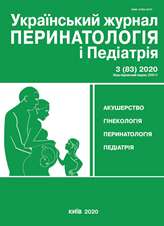Correction of stress hyperglycemia in surgical patients with metabolic syndrome
DOI:
https://doi.org/10.15574/PP.2020.83.26Keywords:
surgical patients, diabetes mellitus, hyperglycemia, infusion therapy, metabolic syndrome, XylatumAbstract
Taking into account that stress and diabetic hyperglycemia is an independent risk factor for increased mortality in surgical patients with metabolic syndrome, an increase in the time spent by patients in intensive care units and the cost of treatment, it is important to carry out treatment, in particular, infusion therapy with the appointment of drugs that do not increase glucose levels and help to reduce the need for insulin in patients with diabetes mellitus in the postoperative period.
Aim is to assess the effectiveness of the drug Xylat as an integral component of intensive care for patients with metabolic syndrome in perioperative period.
Materials and methods. The study was conducted in 21 women with metabolic syndrome who underwent urgent surgical intervention for tumors in pelvic area. All patients received Xylat (Yuria-Pharm) – 5-6 ml/kg/day, 50-70 drops/min for 3 days in the postoperative period. The control group consisted of 15 women with metabolic syndrome, who underwent surgical treatment in the regional clinical hospital for ovarian tumors, but received alternative infusion therapy during the postoperative period (according to archived case histories).
Results. The data of our study showed that the drug Xylatum (Yuria-Pharm) helps to reduce the risk of the severity of stress hyperglycemia, suppresses the risk of lactacidemia, provides energy support for postoperative patients with diabetes mellitus with an insulin+independent metabolism, and stimulates the production of endogenous insulin in critically ill patients.
Conclusions. With the use of Xylate, the tolerance to carbohydrates increases. It has a very low glycemic index, antiketogenic properties, does not adversely affect the central nervous system, the exchange of hormones and neurotransmitters.
The research was carried out in accordance with the principles of the Helsinki Declaration. The study protocol was approved by the Local Ethics Committee of these Institutes. The informed consent of the patient was obtained for conducting the studies.
References
American Diabetes Association. (2007, Jan 30). Nutrition Recommendations and Interventions for Diabetes. A position statement of the American Diabetes Association. Diabetes Care. 1: 48-65. https://doi.org/10.2337/dc07-S048; PMid:17192379
Bar-Or D, Carrick M, Tanner A, Lieser MJ, Rael LT, Brody E. (2018, Feb). Overcoming the Warburg Effect: Is It the Key to Survival in Sepsis? Journal of Critical Care. 43: 197-201. https://doi.org/10.1016/j.jcrc.2017.09.012; PMid:28915394
Bar-Or D, Rael LT, Madayag RM, Banton KL, Tanner II A, Acuna DL et al. (2019, Mar 27). Stress Hyperglycemia in Critically Ill Patients: Insight Into Possible Molecular Pathways. Frontiers in Medicine: Intensive Care Medicine & Anesthesiology. https://doi.org/10.3389/fmed.2019.00054; PMid:30972338 PMCid:PMC6445875
Berhane F, Fite A, Daboul N, Al-Janabi W, Msallaty Z, Caruso M et al. (2015, Apr 19). Plasma Lactate Levels Increase during Hyperinsulinemic Euglycemic Clamp and Oral Glucose Tolerance Test. Journal of Diabetes Research. https://doi.org/10.1155/2015/102054; PMid:25961050 PMCid:PMC4417566
Brault C, Zerbib Y, Delette C, Marc J, Gruson B, Marolleau JP et al. (2018, Jun 20). The Warburg Effect as a Type B Lactic Acidosis in a Patient with Acute Myeloid Leukemia: A Diagnostic Challenge for Clinicians. Frontiers in Oncology. 8: 232. https://doi.org/10.3389/fonc.2018.00232; PMid:29974036 PMCid:PMC6019439
Green JP, Berger T, Garg N, Horeczko T, Suarez A, Radeos MS et al. (2012, Nov 20). Hyperlactatemia Affects the Association of Hyperglycemia with Mortality in Nondiabetic Adults with Sepsis. Academic Emergency Medicine. 19 (11): 1268-1275. URL: https://onlinelibrary.wiley.com/doi/full/10.1111/acem.12015; https://doi.org/10.1111/acem.12015; PMid:23167858 PMCid:PMC3506124
Natesan V. (2018, Feb). Adrenergic Blockade Inhibits Bacterial Quorum Sensing and Reverses Warburg Effect in Septic Shock. British Journal of Anaesthesia. 120 (2): 412-413. https://doi.org/10.1016/j.bja.2017.12.010; PMid:29406196
Packer M. (2017, Oct 17). Activation and Inhibition of Sodium-Hydrogen Exchanger Is a Mechanism That Links the Pathophysiology and Treatment of Diabetes Mellitus With That of Heart Failure. Circulation. 136 (16): 1548-1559. URL: https://www.ahajournals.org/doi/pdf/10.1161/CIRCULATIONAHA.117.030418. https://doi.org/10.1161/CIRCULATIONAHA.117.030418; PMid:29038209
Shanik MH, Xu Y, ?krha J, Dankner R, Zick Y, Roth J. (2008, Feb 31). Insulin Resistance and Hyperinsulinemia. Is hyperinsulinemia the Cart or the Horse? Diabetes Care. 2: 262-268. https://doi.org/10.2337/dc08-s264; PMid:18227495
Stapleton RD, Heyland DK. (2018, Jul 24). Glycemic Control and Intensive Insulin Therapy in Critical Illness. UpToDate. URL: https://www.upto-date.com/contents/glycemic-control-and-intensive-insulin-therapy-in-critical-illness.
Downloads
Published
Issue
Section
License
The policy of the Journal “Ukrainian Journal of Perinatology and Pediatrics” is compatible with the vast majority of funders' of open access and self-archiving policies. The journal provides immediate open access route being convinced that everyone – not only scientists - can benefit from research results, and publishes articles exclusively under open access distribution, with a Creative Commons Attribution-Noncommercial 4.0 international license(СС BY-NC).
Authors transfer the copyright to the Journal “MODERN PEDIATRICS. UKRAINE” when the manuscript is accepted for publication. Authors declare that this manuscript has not been published nor is under simultaneous consideration for publication elsewhere. After publication, the articles become freely available on-line to the public.
Readers have the right to use, distribute, and reproduce articles in any medium, provided the articles and the journal are properly cited.
The use of published materials for commercial purposes is strongly prohibited.

